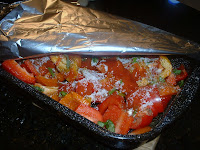Although Bruschetta can be topped with one of many possibilities there’s nothing more classic to include in a delicious Antipasto spread than Tomato Bruschetta.
I've always been interested in the origin of food and my curiosity confirmed what I had already suspected about the origin of this truly delicious combination of flavours and textures.
History reveals that people have been eating Bruschetta since the 15th century but perhaps in a different way that it is served today. We seem to be enjoying a more refined version of this dish whereas in times past “rustic” might be the key word.
This was originally poor man’s food, a snack or meal taken to the fields by those who spent the day working there. At best, it consisted of stale bread with a drizzle of olive oil and salt only improved by the addition of a few ripe tomatoes on top.
The word Bruschetta correctly pronounced [bru'sket:ta] originates from the Roman dialect and literally translates “ to roast over coals”. (If pronounced correctly your taste experience will reach new heights.)
Here we thought it was about the topping but it's really all about the bread!
I suppose toasting the bread on the barbeque would be as close as we may ever get to the authentic preparation of "roasting over coals" but a panini grill or broil function on the oven have served me very well over the years.
While growing up I don’t recall my mother ever making Bruschetta as part of an Antipasto. Perhaps this was because we enjoyed it as a totally different experience and definitely didn’t call it Bruschetta.
I remember how she would transform what were basically pieces of stale, hard, leftover bread into lunch fit for a queen. A generous drizzle of olive oil and a few ripe tomatoes would be squeezed onto the bread until the juices permeated and made it slightly softer. It was then finished off with sprinkling of salt, oregano and thin slices of sweet onion.
It was never called Bruschetta but known to us as “pane, olio e sale” translated “bread, oil and salt.” Of course these words were spoken in her Italian dialect which are next to impossible to write down but simply music to our ears.
It seems that nothing can stop a good recipe, this one has traveled through the centuries and has only gotten better with time although my mother's version has remained somewhat unchanged.
On occasion, when the craving strikes and nothing else in the fridge will do, I visit the container where I store the hardened bread reserved for making breadcrumbs and retrieve a few pieces.
I'll leave the rest to your imagination.
Tomato Bruschetta
french stick, baguette or any other variety of crusty bread
olive oil
salt
pepper (optional)
oregano
ripe tomatoes
scallions or any variety of sweet onion
basil
- Prepare bread (see preparation of bread in recipe for Roasted Pepper and Olive Crostini)
- Remove as much of the seeds in ripe tomatoes as possible and chop into small pieces and place in a bowl.
- Finely chop onion and basil and add to tomatoes along with oil, salt, pepper and oregano.
- Mix well.
- This can be made a few hours ahead and left for the flavours to marry or can be used right away.
- Spoon the mixture onto prepared bread.
Notes, Tips and Suggestions
- Even though most varieties of tomato can be used, the Roma variety holds its shape best without becoming mushy.
- Ripe tomatoes work best for flavour and texture.
- If you don’t prefer adding onions, finely chopped chives add a more subtle onion flavour.
- Use a good virgin olive oil for the best taste experience.
- For something different add a few small pieces of soft bocconcini cheese on top of the tomato mixture.
- For a party idea leave the tomato mixture in the bowl place in the center of a large platter and place toasted bread all around. Guests can assemble their own.
- Don’t prepare too far in advance of eating to prevent soggy bread.
- When toasting the bread the outside should be crisp but inside should still be soft and chewy.
- I find better results in using bread that is a few days old instead of a fresh loaf.
























